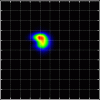The goal of the shift was to evaluate the effect of SR alignment with the ITF locked in CARM null configuration. Additionally, other tests have been performed, like the effect of an offset on DARM in the same configuration.
At the beginning of the shift a test together with Romain G. was performed on the drift control of SPRB (see 54054).
After the test was done, we started with the planned activity:
SR (mis)alignment:
For this series of tests we had 5 locks at CARM offset zero: 16.24 UTC, 1734 UTC, 18.04 UTC, 20.40 UTC, and 21.10 UTC, which lasted averagely 30 minutes.
One first different behaviour is the response of the upper and lower SB. Indeed, during the transition to CARM null they didn't exchange immediately, but after a small period of time.
During the first lock we just moved the SR in the positive direction of TY of 1 urad. The effect was immediate: as shown in Fig.1 an increase of the DC powers signals occured, together with a decrease of the value of B1p_DC signal (noticeable as well on the dark fringe cam); the upper and lower sidebands started to balance each other and to behave constantly for the rest of the lock, which lasted around 25 mins.
Following this path, the other locks at CARM null were done increasing the misalignment in order to improve the lock stability (referring to the figures of merit trends).
The second lock (Fig.2) behaved the same as the previous with a overall misalignment of 2 urad.
During the third lock (Fig.3) we explored more misalignment positions of the SR in the same direction. What is noticeable from the plot is that:
- before the swapping of the upper and lower SB, the misalignment of the SR didn't seem to have any effect;
- after this swap, the effect of the SR misalignment is the one described for the first lock (darkening of the fringe and balancing of the 112 MHz and 12 MHz sb ecc, increase of powers...ecc..);
- going on with the misalignment (up to 4 urad) the upper and lower SB swapped again, together with a overall improvement of the lock figures of merit;
- we tried to misalign of 1 more urad (5 overall), but the effect was negative, leading to a brightening of the fringe and general instability with unlock.
During the 4th lock we explored the negative direction of SR misalignment, with an overall misalignment of 4 urad, but we didn't obtain any major improvement as we did with the other direction.
At the 5th lock we tried to go directly to +4 urad of misalignment (the best position explored so far), and tried to complete the full acquisition: we were able to close the SSFS (21.25 UTC). After some minutes we wanted to perform the handoff of MICH and PRCL to the 1f signals but we unlocked.
N.B. For every misalignment step of the SR, corresponds an increase of the DARM UGF, which needs to be manually compensated tuning accordingly the DARM Gain. (We noticed that even if the optimal UGF for DARM is 45 Hz, today the loop behaved more stably with a lower UGF, around 38 Hz).
DARM offset:
In order to evaluate the effect of DARM offset on the stability of the lock, we performed some tests, in which we applied some offset in both negative and positive directions (see Fig.s from 6 to 8). The expected effect was a general worsening of the fringe together with the increase of such offset. Every offset, even if little and with a slow enough ramp, led the ITF to unlock due to heavy brightening of the fringe.
A better analysis of the data of this shift will be further performed. More tests will be performed in the following shifts as well.
We left the ITF with the arms locked on the IR.

























